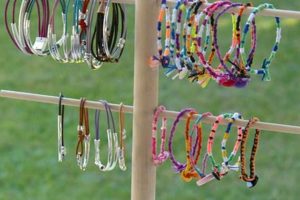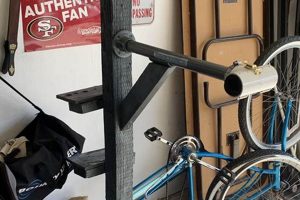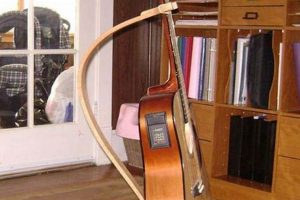The assembly of an archery practice support, crafted from readily available materials, facilitates the safe and effective training of marksmanship skills. This self-made apparatus typically involves a frame or structure designed to securely hold a target, preventing it from falling or shifting during arrow impact. These are often constructed with lumber, PVC piping, or repurposed materials, offering a cost-effective alternative to commercially manufactured options.
The importance of constructing a stable and reliable support for archery targets stems from safety considerations and the desire to improve shooting accuracy. A poorly constructed support could lead to target displacement, causing arrows to ricochet unpredictably. Moreover, a consistent target presentation fosters a more accurate and repeatable shooting experience, ultimately enhancing skill development. Historically, archers have employed various methods to secure targets, ranging from simple earthen mounds to more elaborate wooden frameworks.
Subsequent sections will detail specific design considerations, material selection guidelines, and step-by-step construction methods for creating robust and functional archery practice supports. The discussion will also encompass safety precautions and best practices to ensure a positive and secure archery experience.
Essential Considerations for a Self-Made Archery Target Support
The following tips offer guidance on constructing a durable and effective archery target support, ensuring safety and optimal performance during practice.
Tip 1: Prioritize Stability: The foundation of the support must be sufficiently wide and heavy to prevent tipping, particularly when subjected to repeated arrow impacts. Consider using sandbags or concrete blocks to increase base weight.
Tip 2: Select Appropriate Materials: Choose materials resistant to weathering and impact damage. Pressure-treated lumber or heavy-duty PVC are suitable options. Avoid thin or brittle materials prone to splintering.
Tip 3: Ensure Target Compatibility: Design the support to accommodate the size and type of target being used. Consider adjustability to allow for different target dimensions or orientations.
Tip 4: Incorporate Arrow Containment: Implement a backstop or containment system behind the target to minimize the risk of arrows passing through and causing injury. This can be achieved with netting or stacked bales of straw.
Tip 5: Maintain Proper Target Height: Position the target at a comfortable and consistent height for the archer. Typically, the center of the target should be at chest level.
Tip 6: Implement Weather Protection: If the target support will be left outdoors, apply a weather-resistant sealant or coating to protect the materials from moisture damage and prolong its lifespan. Consider adding a roof to keep the target itself dry.
Tip 7: Conduct Regular Inspections: Routinely examine the target support for signs of damage, such as cracks, splinters, or loose connections. Repair or replace damaged components promptly to maintain structural integrity and prevent accidents.
Adherence to these guidelines will contribute to the creation of a safe and functional archery practice environment. Proper construction and maintenance of the target support are paramount for both performance and personal safety.
The ensuing sections will delve into detailed construction plans and specific material recommendations, providing a comprehensive guide to building a professional-grade archery target support.
1. Material Strength
Material strength constitutes a foundational principle in the effective design and construction of a self-made archery target support. The capacity of the chosen material to withstand repeated arrow impacts and environmental stressors dictates the support’s longevity, stability, and overall safety.
- Tensile Strength and Arrow Impact
Tensile strength, or the material’s resistance to being pulled apart, directly affects its ability to withstand repeated arrow impacts. Materials with low tensile strength, such as certain low-grade plastics, are prone to cracking or shattering upon impact, leading to premature failure of the target support. Utilizing materials like steel or reinforced polymers, which exhibit high tensile strength, ensures the support can endure the stress of numerous arrow strikes without compromising its structural integrity.
- Compressive Strength and Load Bearing
Compressive strength, representing a material’s resistance to being crushed, is crucial for the support’s load-bearing capacity. The weight of the target itself, along with any additional loads such as sandbags for stability, places a compressive force on the support structure. Materials with insufficient compressive strength may deform or buckle under these loads, causing the target to become unstable. Dense hardwoods or concrete blocks are examples of materials with high compressive strength, suitable for supporting substantial weight.
- Shear Strength and Joint Integrity
Shear strength, the material’s ability to resist forces acting parallel to its surface, is particularly important at joints and connections within the target support structure. Fasteners such as screws or bolts rely on the material’s shear strength to maintain a secure connection. Materials with low shear strength may allow fasteners to pull through or loosen over time, weakening the overall structure. Using high-quality fasteners in conjunction with materials like treated lumber, known for its shear strength, ensures robust joint integrity.
- Flexural Strength and Resistance to Bending
Flexural strength, representing a material’s ability to resist bending under load, is relevant to the support’s ability to maintain its shape and alignment. Wind forces, uneven ground surfaces, or accidental impacts can induce bending stresses within the structure. Materials with low flexural strength may deflect or warp under these stresses, affecting target presentation. Steel tubing or laminated wood, possessing high flexural strength, resists bending and maintains a consistent target plane.
The careful consideration of tensile, compressive, shear, and flexural strength properties of materials is paramount to ensure the creation of durable, safe, and effective support. The selection of appropriate materials, coupled with sound construction techniques, contributes directly to the long-term performance and reliability of a self-constructed archery target support.
2. Structural Stability
Structural stability is a critical attribute of any self-constructed archery target support. A stable stand minimizes movement during arrow impact, preventing target displacement and ensuring consistent shot placement. Lack of stability can lead to unpredictable arrow trajectories, compromising accuracy and, more importantly, creating a potentially unsafe shooting environment. The relationship between structural stability and these supports is causal: the design and execution of a stable structure directly affect the accuracy and safety of archery practice.
The implementation of triangulated support systems within the stand’s framework represents a common method of enhancing structural stability. Triangles inherently resist deformation, providing a rigid and stable base. For example, a simple A-frame constructed with appropriately sized lumber and secured with robust fasteners offers a substantial improvement in stability compared to a similar frame with unsupported rectangular joints. Weight distribution is another significant factor. A low center of gravity, achieved by widening the base and adding weight to the lower sections of the stand, further reduces the risk of tipping or shifting during use. Consider the scenario of an archer using a high-poundage bow; the force of the arrow impacting the target will exert a considerable force on the stand. A structurally unsound stand will likely wobble or tip, rendering the shot ineffective and potentially dangerous.
In conclusion, structural stability is not merely a desirable characteristic but an essential requirement for a safe and effective self-constructed archery target support. Prioritizing robust design principles, appropriate material selection, and careful construction techniques directly translates into a more predictable and secure archery experience. The understanding of structural stability principles mitigates safety risks and optimizes shooting accuracy, underscoring its paramount importance within the context of archery practice.
3. Target Compatibility
Target compatibility is a crucial consideration when constructing an archery target support. The support’s design must accommodate the dimensions, weight, and material properties of the intended target to ensure safe and effective use. Ignoring this factor can lead to instability, target damage, and compromised shooting accuracy.
- Size and Dimensions
The physical size of the target dictates the required dimensions of the support structure. A large target necessitates a wider and taller support to provide adequate stability and prevent tipping. Conversely, a small target may require a more compact support to maintain proper target alignment and prevent excessive movement. Failure to account for target size can result in an undersized support that collapses under the target’s weight or an oversized support that is unnecessarily bulky and difficult to transport.
- Weight Distribution
The weight of the target and its distribution across the support structure impact the overall stability of the assembly. A heavy target concentrated in one area can create an unbalanced load, increasing the risk of tipping. Distributing the target’s weight evenly across the support structure, through the use of multiple support points or a wider base, enhances stability and reduces the likelihood of accidental collapse. This principle is particularly important when using layered foam targets or targets filled with dense materials.
- Material Composition
The material composition of the target influences the type of support required. Soft targets, such as those made from foam or burlap, may require a simple frame to maintain their shape and prevent sagging. Harder targets, such as those made from wood or plastic, may require a more robust support structure capable of withstanding repeated arrow impacts without deformation. Understanding the target’s material properties allows for the selection of appropriate support materials and construction techniques.
- Attachment Method
The method used to attach the target to the support structure directly affects its stability and ease of use. Simple hanging mechanisms may be suitable for lightweight targets, while more secure attachment methods, such as bolting or strapping, may be necessary for heavier targets. The attachment method should also allow for easy target replacement or adjustment as needed. Inadequate attachment can result in the target detaching from the support during use, posing a safety hazard.
In summary, the successful integration of an archery target with its support depends heavily on carefully considering the target’s size, weight distribution, material composition, and attachment method. A well-designed support that addresses these factors will enhance both safety and performance during archery practice.
4. Weather Resistance
Weather resistance is a critical factor in the longevity and usability of a self-constructed archery target support, particularly when the stand is intended for outdoor use. Exposure to environmental elements such as rain, sunlight, and temperature fluctuations directly impacts the structural integrity and material properties of the support. A poorly weather-resistant stand can deteriorate rapidly, leading to instability, potential safety hazards, and ultimately, the need for frequent repairs or replacement.
The selection of appropriate materials and the application of protective coatings are key strategies for enhancing weather resistance. Pressure-treated lumber, for example, is specifically designed to resist rot and decay caused by moisture, making it a suitable choice for outdoor archery target supports. Similarly, the use of galvanized steel or powder-coated metal components can prevent rust and corrosion. Applying a weather-resistant sealant or paint to all exposed surfaces further protects the materials from the elements. Consider a scenario where a support is constructed from untreated wood and left exposed to regular rainfall; the wood will eventually warp, crack, and become susceptible to fungal growth, compromising the stand’s stability and lifespan. In contrast, a properly treated and protected stand can withstand years of outdoor exposure with minimal degradation.
In conclusion, neglecting weather resistance in the design and construction of an archery target support can result in significant long-term costs and potential safety risks. Prioritizing the use of weather-resistant materials and protective coatings is essential for ensuring the durability, stability, and safe operation of the stand. The incremental cost of these measures is often significantly less than the cost of frequent repairs or replacement, making weather resistance a prudent investment for any outdoor archery enthusiast.
5. Arrow Containment
Arrow containment is a critical safety component in the design and construction of any self-made archery target support. The primary function of arrow containment is to prevent errant or pass-through arrows from traveling beyond the immediate target area, thus mitigating the risk of accidental injury or property damage. The absence of effective arrow containment transforms an archery practice area into a potential hazard zone. The integration of arrow containment measures directly addresses the potential consequences of missed shots or target failures.
Examples of arrow containment strategies employed in self-constructed target supports range from simple backstops to more elaborate enclosed systems. A basic backstop might consist of a wall of tightly packed straw bales positioned behind the target. Alternatively, netting constructed from durable materials can be suspended behind the target to intercept stray arrows. More advanced designs incorporate enclosed frames filled with energy-absorbing materials, providing a comprehensive barrier against arrow penetration. The selection of an appropriate arrow containment method depends on factors such as the draw weight of the bow being used, the type of arrows being shot, and the available space for the archery range. Practical application of this understanding ensures that all potential arrow paths are effectively blocked, creating a safer environment for both the archer and any bystanders.
In conclusion, arrow containment is not an optional feature but an indispensable element of responsible archery practice. The incorporation of effective arrow containment measures into the design of a self-made archery target support demonstrates a commitment to safety and minimizes the potential for accidents. Prioritizing arrow containment is essential for creating a secure and enjoyable archery experience.
Frequently Asked Questions
This section addresses common inquiries regarding the construction and utilization of self-made archery target supports, focusing on safety, durability, and optimal performance.
Question 1: What constitutes the most critical safety consideration when constructing a self-made archery target stand?
The paramount safety consideration revolves around ensuring structural stability and effective arrow containment. An unstable stand presents a tipping hazard, while inadequate arrow containment can lead to stray arrows causing injury or property damage.
Question 2: What materials are best suited for a weather-resistant archery target stand designed for outdoor use?
Pressure-treated lumber, galvanized steel, and UV-resistant plastics are suitable materials. Furthermore, the application of a weather-resistant sealant or paint is advisable to mitigate the effects of moisture and sunlight exposure.
Question 3: How does target size and weight affect the design of an archery target support?
Larger and heavier targets necessitate a wider and more robust support structure to maintain stability and prevent tipping. The weight distribution of the target must be considered to ensure balanced load-bearing capacity.
Question 4: What methods can be employed to enhance the structural stability of a self-made archery target stand?
Implementing triangulated support systems, widening the base for increased stability, and adding weight to the lower sections of the stand are effective methods for enhancing structural stability.
Question 5: Is it necessary to incorporate arrow containment measures into the design of an archery target stand?
Yes, arrow containment is an essential safety feature. Measures such as backstops made of straw bales or netting constructed from durable materials must be integrated to prevent errant arrows from traveling beyond the immediate target area.
Question 6: How frequently should a self-made archery target stand be inspected for damage?
Regular inspections are crucial. The stand should be inspected before each use for signs of structural damage, such as cracks, splinters, or loose connections. Any damage must be repaired or addressed promptly to maintain safety and prevent accidents.
In summary, the construction of a safe and effective archery target stand requires careful attention to material selection, structural design, and safety considerations. Regular maintenance and inspection are essential for ensuring long-term performance and preventing accidents.
The subsequent section will provide detailed step-by-step instructions for constructing a durable and reliable archery target stand.
DIY Bow Target Stand
The preceding discussion has explored the multifaceted considerations inherent in constructing a “diy bow target stand”. From material selection to structural integrity and, critically, safety features such as arrow containment, the process demands careful planning and execution. A properly constructed support not only enhances the archer’s practice experience but also mitigates potential risks associated with projectile sports.
The information presented serves as a foundation for informed decision-making. The responsibility for safe construction and use rests solely with the individual. Continuing research and diligent adherence to safety guidelines are paramount. The effectiveness of any “diy bow target stand” is ultimately measured by its contribution to a safe and productive archery environment.







